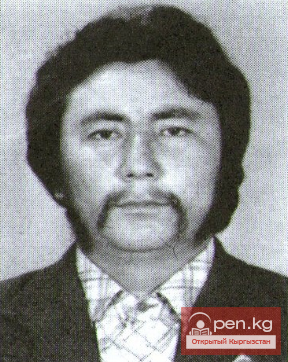API error: no response...

Olga Maximilianovna Manuilova (1893-1984) Sculptor. People's Artist of the Kyrgyz SSR. Born...

Usubaliev Altymysh (1930-1970) Painter. Born on December 12, 1930, in the village of Tokoldosh...

Shestopal Viktor Arnoldovich Sculptor. People's Artist of the Kyrgyz Republic. Laureate of...
API error: no response...
API error: no response...

Aitieva Gapar Aitieviсh Painter. Corresponding Member of the Academy of Arts of the USSR,...

Paper banknotes with a denomination of 1 tyiyn, serving as change coins. The banknote is made of...

Paper banknotes with a denomination of 10 tyiyn, serving as change coins....

Artistic and Stylistic Range of Young Artists' Works Possessing a gift for painting, most of...
API error: no response...
Curl error: HTTP/2 stream 0 was not closed cleanly: INTERNAL_ERROR (err 2)...

Stukoshin Fyodor Mikhailovich (1914-1974) Painter. Born on February 18, 1914, in the village of...

Beknazarov Kanat Sagynbekovich Painter. Born on July 19, 1957, in the village of Kalba, Talas...

The 50 som banknote of the 2009 series is printed on white paper measuring 126x61 mm. The...

Burlyn Grigory Danilovich Sculptor. Born on February 13, 1915, in the village of Goryachevodsk...

Kheidze David Vladimirovich Sculptor. Born on May 31, 1935, in the city of Tuapse, Krasnodar Krai....

Sheshukov Sergey Fedorovich Graphic artist. Born on August 29, 1952, in the village of Avdreevka,...

Mambetov Emilbek Beyshevich Painter. Born on June 2, 1966, in the village of Kok-Zhar, Kochkor...

Chuykov Semyon Afanasyevich (1902 -1980) Painter. People's Artist of the USSR. Full member of...

The 1000 som banknote of the 2010 series is made of white paper measuring 150x71 mm. The...

Torobekov Suuitbek Satymbekovich Painter. Honored Worker of Culture of the Kyrgyz Republic....

Ovchinnikova Natalia Ivanovna Painter. Born on May 30, 1960, in the city of Frunze. In 1977, she...

Kasymbekov Turgunbek Painter. Born on May 13, 1946, in the village of Chon-Zhar, Sokuluk District,...

Sydykov Bazarbek Kimbildievich Sculptor. Born on June 27, 1953, in the village of Leninpol, Talas...

Zhaylobaev Talam Karagulovich Painter. Born on June 10, 1950, in the village of Konur-Olon, Ton...
API error: no response...

5 som banknote of 1993 is made of white paper measuring 140x70 mm. The predominant color of the...
Curl error: HTTP/2 stream 0 was not closed cleanly: INTERNAL_ERROR (err 2)...

Natural and compositional drawing is a subject of close attention from R. Nudel, a multifaceted...

Voronin Alexander Fedorovich Monumentalist. Painter. Born in 1935 in the village of Balaki,...

Expressive genre sheets were created by S. Chokmorov ("Men Sitting," 1964), A. Ostashev...

Sculptural Monuments. Togolok Moldo In the monumental sculpture of Kyrgyzstan, which began to be...

Success was more easily achieved through traditional means of plein air painting, especially...

Sadikov Turgunbay Sadikovich Sculptor. Hero of the Kyrgyz Republic, People's Artist of the...

Akylbekov Sabyrbek Mambetsadykovich Painter. Honored Artist of the Kyrgyz SSR. Born on February...

Eshbaev Mamyraly Painter. Born on January 1, 1959, in the village of Yzar, Ala-Buka district,...

The 1 som banknote of 1993 is made of white paper measuring 140x70 mm. The predominant color of...

Bekdzhanov Murat Poster artist. Painter. Honored Worker of Culture of the Kyrgyz Republic. Born on...
API error: no response...

Kozhegulov Almaz Sulaymanovich Sculptor. Born on February 14, 1958, in the village of Buruldai. In...

Kongurbaev Nurdamir Ashimovich Painter. Honored Worker of Culture of the Kyrgyz Republic. Born on...

Baibosunov Tabyldy Belekovich Painter. Honored Worker of Culture of the Kyrgyz Republic. Born on...

Khabibulin Zaur Alexandrovich (1937-1988) Sculptor. Born on November 11, 1937, in Krasnoyarsk. In...

An original master of landscape is Naryn Turpanov. Unlike most artists, he immediately found his...

Sadikov Turgunbay – Kyrgyz sculptor and monumental artist, chairman of the cultural foundation of...

Population of Kyrgyzstan Thanks to the fundamental changes that occurred in Kyrgyzstan after the...